Myrmecina americana
| Myrmecina americana | |
|---|---|

| |
| Scientific classification | |
| Kingdom: | Animalia |
| Phylum: | Arthropoda |
| Class: | Insecta |
| Order: | Hymenoptera |
| Family: | Formicidae |
| Subfamily: | Myrmicinae |
| Tribe: | Crematogastrini |
| Genus: | Myrmecina |
| Species: | M. americana |
| Binomial name | |
| Myrmecina americana Emery, 1895 | |
| Synonyms | |
| |
This species nests under stones, in the soil and in acorns on the ground. Workers are predaceous and are not known to tend Homoptera.
Photo Gallery
Identification
Keys including this Species
Distribution
Latitudinal Distribution Pattern
Latitudinal Range: 46.66° to 24.48472222°.
| North Temperate |
North Subtropical |
Tropical | South Subtropical |
South Temperate |
- Source: AntMaps
Distribution based on Regional Taxon Lists
Nearctic Region: United States (type locality).
Neotropical Region: Mexico.
Distribution based on AntMaps
Distribution based on AntWeb specimens
Check data from AntWeb
Countries Occupied
| Number of countries occupied by this species based on AntWiki Regional Taxon Lists. In general, fewer countries occupied indicates a narrower range, while more countries indicates a more widespread species. |

|
Biology
This is a common species in deciduous forests of southern New England. Sifting litter and soil in such forests, it is not difficult to find individuals of Myrmecina americana. What is difficult is finding more than one or two individuals at once. Nests are hard to find and generally these ants are rarely seen since their foragers do not venture out into exposed areas of the forest floor.
Headley (1943) reported finding nests of Myrmecina americana in Oak acorns.
Association with Other Organisms
 Explore: Show all Associate data or Search these data. See also a list of all data tables or learn how data is managed.
Explore: Show all Associate data or Search these data. See also a list of all data tables or learn how data is managed.
- This species is a xenobiont for the ant Formica gnava (a xenobiont) in United States (Kanizsai et al., 2013; Wheeler, 1901).
- This species is a xenobiont for the ant Myrmica pinetorum (a xenobiont) in United States (Kanizsai et al., 2013; Wheeler, 1921).
- This species is a xenobiont for the ant Pheidole picea (a xenobiont) in United States (Kanizsai et al., 2013; Wheeler, 1901).
- This species is a xenobiont for the ant Ponera pennsylvanica (a xenobiont) in United States (Kanizsai et al., 2013; Wheeler, 1901).
Flight Period
| X | X | X | |||||||||
| Jan | Feb | Mar | Apr | May | Jun | Jul | Aug | Sep | Oct | Nov | Dec |
Source: antkeeping.info.
- Check details at Worldwide Ant Nuptial Flights Data, AntNupTracker and AntKeeping.
 Explore: Show all Flight Month data or Search these data. See also a list of all data tables or learn how data is managed.
Explore: Show all Flight Month data or Search these data. See also a list of all data tables or learn how data is managed.
Life History Traits
- Queen number: monogynous (Frumhoff & Ward, 1992)
Castes
Worker
Images from AntWeb
  
| |
| Worker. Specimen code casent0103049. Photographer April Nobile, uploaded by California Academy of Sciences. | Owned by OSEC, Stillwater, OK, USA. |
Images from AntWeb
   
| |
| Worker. Specimen code casent0102853. Photographer Jen Fogarty, uploaded by California Academy of Sciences. | Owned by CAS, San Francisco, CA, USA. |
 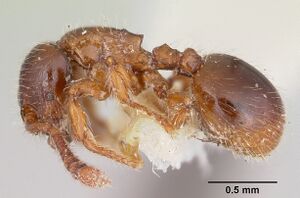 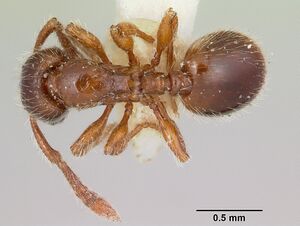 
| |
| Worker. Specimen code casent0103137. Photographer April Nobile, uploaded by California Academy of Sciences. | Owned by USNM, Washington, DC, USA. |
 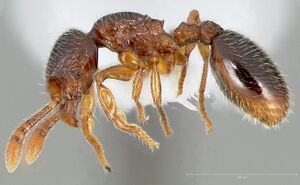 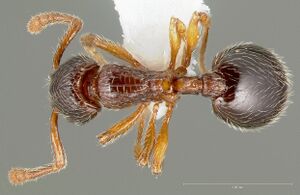 
| |
| Worker. Specimen code casent0005696. Photographer April Nobile, uploaded by California Academy of Sciences. | Owned by UCDC, Davis, CA, USA. |
Queen
Images from AntWeb
 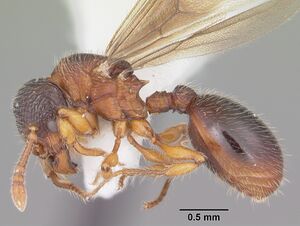  
| |
| Queen (alate/dealate). Specimen code casent0104119. Photographer April Nobile, uploaded by California Academy of Sciences. | Owned by ABS, Lake Placid, FL, USA. |
   
| |
| . | |
Male
Images from AntWeb
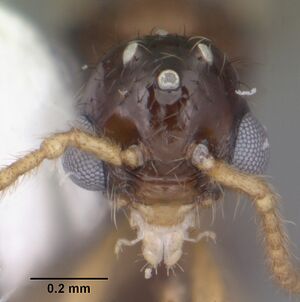  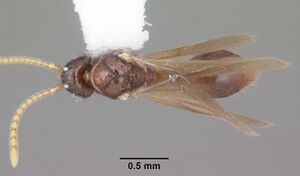 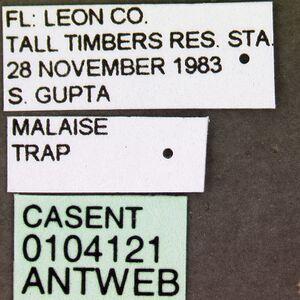
| |
| Male (alate). Specimen code casent0104121. Photographer April Nobile, uploaded by California Academy of Sciences. | Owned by ABS, Lake Placid, FL, USA. |
Nomenclature
The following information is derived from Barry Bolton's Online Catalogue of the Ants of the World.
- americana. Myrmecina latreillei subsp. americana Emery, 1895c: 271 (w.) U.S.A. Wheeler, G.C. & Wheeler, J. 1954c: 130 (l.). Subspecies of graminicola: Wheeler, W.M. 1904e: 300; Wheeler, W.M. 1906b: 1. Raised to species: Brown, 1949a: 44; Creighton, 1950a: 248. Senior synonym of brevispinosa: Smith, D.R. 1979: 1399; of quadrispina: Brown, 1949a: 44; of texana: Brown, 1951: 103; Brown, 1967c: 236; of californica: Brown, 1967c: 236. See also: Snelling, R.R. 1965b: 101.
- texana. Myrmecina graminicola subsp. texana Wheeler, W.M. 1908e: 422 (w.) U.S.A. Subspecies of americana: Creighton, 1950a: 250. Junior synonym of americana: Brown, 1967c: 236.
- quadrispina. Myrmecina graminicola subsp. quadrispina Enzmann, J. 1946a: 13, figs. 1, 2 (w.) U.S.A. Junior synonym of americana: Brown, 1949a: 44.
- californica. Myrmecina californica Smith, M.R. 1948: 239 (w.) U.S.A. Subspecies of americana: Snelling, R.R. 1965b: 104. Junior synonym of americana: Brown, 1967c: 236.
- brevispinosa. Myrmecina americana subsp. brevispinosa Creighton, 1950a: 249 (w.q.m.) U.S.A. [First available use of Myrmecina latreillei subsp. americana var. brevispinosa Emery, 1895c: 271; unavailable name.] Subspecies of americana: Snelling, R.R. 1965b: 105. Junior synonym of americana: Smith, D.R. 1979: 1399.
Description
Karyotype
- See additional details at the Ant Chromosome Database.
 Explore: Show all Karyotype data or Search these data. See also a list of all data tables or learn how data is managed.
Explore: Show all Karyotype data or Search these data. See also a list of all data tables or learn how data is managed.
- n = 14 (Crozier, 1975).
Worker Morphology
 Explore: Show all Worker Morphology data or Search these data. See also a list of all data tables or learn how data is managed.
Explore: Show all Worker Morphology data or Search these data. See also a list of all data tables or learn how data is managed.
- Caste: monomorphic
References
- Alatorre-Bracamontes, C.E., Vásquez-Bolaños, M. 2010. Lista comentada de las hormigas (Hymenoptera: Formicidae) del norte de México. Dugesiana 17(1): 9-36.
- Brown, W. L., Jr. 1949a. Synonymic and other notes on Formicidae (Hymenoptera). Psyche (Camb.) 56: 41-49 (page 44, Raised to species)
- Brown, W. L., Jr. 1949a. Synonymic and other notes on Formicidae (Hymenoptera). Psyche (Camb.) 56: 41-49 (page 44, Senior synonym of quadrispina)
- Brown, W. L., Jr. 1967c. Studies on North American ants. II. Myrmecina. Entomol. News 78: 233-240 (page 236, Senior synonym of californica)
- Brown, W. L., Jr. 1967c. Studies on North American ants. II. Myrmecina. Entomol. News 78: 233-240 (page 236, Senior synonym of texana)
- Brown, W.L., Jr. 1951. New synonymy of a few genera and species of ants. Bulletin of the Brooklyn Entomological Society 46: 101-106 (doi:10.5281/zenodo.24586). (page 103, Senior synonym of texana)
- Cantone S. 2017. Winged Ants, The Male, Dichotomous key to genera of winged male ants in the World, Behavioral ecology of mating flight (self-published).
- Carroll, T.M. 2011. The ants of Indiana (Hymenoptera: Formicidae). M.S. thesis, Purdue University.
- Chick, L.D., Lessard, J.-P., Dunn, R.R., Sanders, N.J. 2020. The coupled influence of thermal physiology and biotic interactions on the distribution and density of ant species along an elevational gradient. Diversity 12, 456 (doi:10.3390/d12120456).
- Creighton, W. S. 1950a. The ants of North America. Bulletin of the Museum of Comparative Zoology 104: 1-585 (page 248, Raised to species)
- Davis, T. 2009. The ants of South Carolina (thesis, Clemson University).
- Deyrup, M.A., Carlin, N., Trager, J., Umphrey, G. 1988. A review of the ants of the Florida Keys. Florida Entomologist 71: 163-176.
- Emery, C. 1895d. Beiträge zur Kenntniss der nordamerikanischen Ameisenfauna. (Schluss). Zool. Jahrb. Abt. Syst. Geogr. Biol. Tiere 8: 257-360 (page 271, Myrmecina latreillei subsp. americana, description of worker)
- Gochnour, B.M., Suiter, D.R., Booher, D. 2019. Ant (Hymenoptera: Formicidae) fauna of the Marine Port of Savannah, Garden City, Georgia (USA). Journal of Entomological Science 54, 417-429 (doi:10.18474/jes18-132).
- Headley, A. E. 1943. Population studies of two species of ants, Leptothorax longispinosus Roger and Leptothorax curvispinosus Mayr. Annals of the Entomological Society of America 36: 743-753 (doi:10.1093/aesa/36.4.743).
- Hill, J.G. 2015. Ants (Hymenoptera: Formicidae) of the Big Thicket Region of Texas. Midsouth Entomologist 8: 24-34.
- Ipser, R.M., Brinkman, M.A., Gardner, W.A., Peeler, H.B. 2004. A survey of ground-dwelling ants (Hymenoptera: Formicidae) in Georgia. Florida Entomologist 87: 253-260.
- Ivanov, K. 2019. The ants of Ohio (Hymenoptera, Formicidae): an updated checklist. Journal of Hymenoptera Research 70: 65–87 (doi:10.3897@jhr.70.35207).
- Kanizsai, O., Lőrinczi, G., Gallé, L. 2013. Nesting associations without interdependence: A preliminary review on plesiobiosis in ants. Psyche 2013, 238602 (doi:10.1155/2013/238602).
- Liu, C., Fischer, G., Liu, Q., Peng, Y.-Q., Economo, E. P., Guenard, B. 2022. Updating the taxonomy of the ant genus Myrmecina (Hymenoptera, Formicidae) in China with descriptions of three new species. Zootaxa, 5182(2), 152-164 (doi:10.11646/zootaxa.5182.2.2).
- MacGown, J.A. 2022. Description of a new species of Myrmecina (Hymenoptera: Formicidae: Myrmicinae) from the southeastern United States. Transactions of the American Entomological Society 149(1): 109-117 (doi:10.3157/061.149.0106).
- MacGown, J.A., Booher, D., Richter, H., Wetterer, J.K., Hill, J.G. 2021. An updated list of ants of Alabama (Hymenoptera: Formicidae) with new state records. Transactions of the American Entomological Society 147: 961-981 (doi:10.3157/061.147.0409).
- Moura, M.N., Cardoso, D.C., Cristiano, M.P. 2020. The tight genome size of ants: diversity and evolution under ancestral state reconstruction and base composition. Zoological Journal of the Linnean Society, zlaa135 (doi:10.1093/zoolinnean/zlaa135).
- Schifani, E., Scupola, A., Alicata, A. 2020. Morphology, ecology and biogeography of Myrmecina sicula André, 1882, rediscovered after 140 years (Hymenoptera, Formicidae). Biogeographia – The Journal of Integrative Biogeography 35, 105–116 (doi:10.21426/b635048444).
- Smith, D. R. 1979. Superfamily Formicoidea. Pp. 1323-1467 in: Krombein, K. V., Hurd, P. D., Smith, D. R., Burks, B. D. (eds.) Catalog of Hymenoptera in America north of Mexico. Volume 2. Apocrita (Aculeata). Washington, D.C.: Smithsonian Institution Press, pp. i-xvi, 1199-2209. (page 1399, Senior synonym of brevispinosa)
- Snelling, R. R. 1965b. Studies on California ants. 2. Myrmecina californica M. R. Smith (Hymenoptera; Formicidae). Bull. South. Calif. Acad. Sci. 64: 101-105 (page 101, see also)
- Waters, J.S., Keough, N.W., Burt, J., Eckel, J.D., Hutchinson, T., Ewanchuk, J., Rock, M., Markert, J.A., Axen, H.J., Gregg, D. 2022. Survey of ants (Hymenoptera, Formicidae) in the city of Providence (Rhode Island, United States) and a new northern-most record for Brachyponera chinensis (Emery, 1895). Check List 18(6), 1347–1368 (doi:10.15560/18.6.1347).
- Wheeler, G. C.; Wheeler, J. 1954c. The ant larvae of the myrmicine tribe Myrmecinini (Hymenoptera). Proc. Entomol. Soc. Wash. 56: 126-138 (page 130, description of larva)
- Wheeler, W.M. 1901. The compound and mixed nests of American ants. The American Naturalist 35(2-3), 513–539, 791–818.
- Wheeler, W.M. 1904f. The ants of North Carolina. Bull. Am. Mus. Nat. Hist. 20: 299-306 (page 300, Subspecies of graminicola)
- Wheeler, W.M. 1905. An annotated list of the ants of New Jersey. Bulletin American Museum of Natural History 21, 371–403.
- Wheeler, W.M. 1906g. Fauna of New England. 7. List of the Formicidae. Occas. Pap. Boston Soc. Nat. Hist. 7: 1-24 (page 1, Subspecies of graminicola)
References based on Global Ant Biodiversity Informatics
- Amstutz M. E. 1943. The ants of the Kildeer plain area of Ohio (Hymenoptera, Formicidae). The Ohio Journal of Science 43(4): 165-173.
- Annotated Ant Species List Ordway-Swisher Biological Station. Downloaded at http://ordway-swisher.ufl.edu/species/os-hymenoptera.htm on 5th Oct 2010.
- Banschbach V. S., and E. Ogilvy. 2014. Long-term Impacts of Controlled Burns on the Ant Community (Hymenoptera: Formicidae) of a Sandplain Forest in Vermont. Northeastern Naturalist 21(1): 1-12.
- Belcher A. K., M. R. Berenbaum, and A. V. Suarez. 2016. Urbana House Ants 2.0.: revisiting M. R. Smith's 1926 survey of house-infesting ants in central Illinois after 87 years. American Entomologist 62(3): 182-193.
- Brown W. L. Jr. 1967. Studies on North American ants. II. Myrmecina. Entomological News 78: 233-240.
- Brown W. L., Jr. 1951. New synonymy of a few genera and species of ants. Bull. Brooklyn Entomol. Soc. 46: 101-106.
- Buren W. F. 1944. A list of Iowa ants. Iowa State College Journal of Science 18:277-312
- Campbell J. W., S. M. Grodsky, D. A. Halbritter, P. A. Vigueira, C. C. Vigueira, O. Keller, and C. H. Greenberg. 2019. Asian needle ant (Brachyponera chinensis) and woodland ant responses to repeated applications of fuel reduction methods. Ecosphere 10(1): e02547.
- Campbell K. U., and T. O. Crist. 2017. Ant species assembly in constructed grasslands isstructured at patch and landscape levels. Insect Conservation and Diversity doi: 10.1111/icad.12215
- Carroll T. M. 2011. The ants of Indiana (Hymenoptera: Formicidae). Master's Thesis Purdue university, 385 pages.
- Choate B., and F. A. Drummond. 2012. Ant Diversity and Distribution (Hymenoptera: Formicidae) Throughout Maine Lowbush Blueberry Fields in Hancock and Washington Counties. Environ. Entomol. 41(2): 222-232.
- Choate B., and F. A. Drummond. 2013. The influence of insecticides and vegetation in structuring Formica Mound ant communities (Hymenoptera: Formicidae) in Maine lowbush blueberry. Environ. Entomol. 41(2): 222-232.
- Clark A. T., J. J. Rykken, and B. D. Farrell. 2011. The Effects of Biogeography on Ant Diversity and Activity on the Boston Harbor Islands, Massachusetts, U.S.A. PloS One 6(11): 1-13.
- Cokendolpher J.C., Reddell J.R., Taylor S.J, Krejca J.K., Suarez A.V. and Pekins C.E. 2009. Further ants (Hymenoptera: Formicidae) from caves of Texas [Hormigas (Hymenoptera: Formicdae) adicionales de cuevas de Texas]. Texas Memorial Museum Speleological Monographs, 7. Studies on the cave and endogean fauna of North America, V. Pp. 151-168
- Colby, D. and D. Prowell. 2006. Ants (Hymenoptera: Formicidae) in Wet Longleaf Pine Savannas in Louisiana. Florida Entomologist 89(2):266-269
- Cole A. C., Jr. 1949. The ants of Mountain Lake, Virginia. Journal of the Tennessee Academy of Science 24: 155-156.
- Coovert G. A. 2005. The Ants of Ohio (Hymenoptera: Formicidae). Ohio Biological Survey, Inc. 15(2): 1-207.
- Coovert, G.A. 2005. The Ants of Ohio (Hymenoptera: Formicidae) Ohio Biological Survey Bulletin New Series Volume 15(2):1-196
- Cover S. P., and R. A. Johnson. 20011. Checklist of Arizona Ants. Downloaded on January 7th at http://www.asu.edu/clas/sirgtools/AZants-2011%20updatev2.pdf
- Dash S. T. and L. M. Hooper-Bui. 2008. Species diversity of ants (Hymenoptera: Formicidae) in Louisiana. Conservation Biology and Biodiversity. 101: 1056-1066
- Dean D. A., and S. R. Dean. 2018. A survey of the ant fauna and seasonal alate nuptial flights at two locations in South-Central Texas. Southwestern Entomologist 43(3): 639-647.
- Del Toro I., K. Towle, D. N. Morrison, and S. L. Pelini. 2013. Community Structure, Ecological and Behavioral Traits of Ants (Hymenoptera: Formicidae) in Massachusetts Open and Forested Habitats. Northeastern Naturalist 20: 1-12.
- Del Toro, I. 2010. PERSONAL COMMUNICATION. MUSEUM RECORDS COLLATED BY ISRAEL DEL TORO
- Deyrup M. 2015. A new species of Myrmecina (Hymenoptera: Formicidae) from southeastern North America. Florida Entomologist 98(4): 1204- 1206.
- Deyrup M., C. Johnson, G. C. Wheeler, J. Wheeler. 1989. A preliminary list of the ants of Florida. Florida Entomologist 72: 91-101
- Deyrup, M. and J. Trager. 1986. Ants of the Archbold Biological Station, Highlands County, Florida (Hymenoptera: Formicidae). Florida Entomologist 69(1):206-228
- DuBois M. B. 1981. New records of ants in Kansas, III. State Biological Survey of Kansas. Technical Publications 10: 32-44
- DuBois M. B. 1985. Distribution of ants in Kansas: subfamilies Ponerinae, Ecitoninae, and Myrmicinae (Hymenoptera: Formicidae). Sociobiology 11: 153-925
- DuBois M. B. 1985. Distribution of ants in Kansas: subfamilies Ponerinae, Ecitoninae, and Myrmicinae (Hymenoptera: Formicidae). Sociobiology 11: 153-926
- DuBois M. B. 1985. Distribution of ants in Kansas: subfamilies Ponerinae, Ecitoninae, and Myrmicinae (Hymenoptera: Formicidae). Sociobiology 11: 153-927
- DuBois M. B. 1985. Distribution of ants in Kansas: subfamilies Ponerinae, Ecitoninae, and Myrmicinae (Hymenoptera: Formicidae). Sociobiology 11: 153-928
- DuBois M. B. 1985. Distribution of ants in Kansas: subfamilies Ponerinae, Ecitoninae, and Myrmicinae (Hymenoptera: Formicidae). Sociobiology 11: 153-929
- DuBois M. B. 1985. Distribution of ants in Kansas: subfamilies Ponerinae, Ecitoninae, and Myrmicinae (Hymenoptera: Formicidae). Sociobiology 11: 153-930
- DuBois M. B. 1985. Distribution of ants in Kansas: subfamilies Ponerinae, Ecitoninae, and Myrmicinae (Hymenoptera: Formicidae). Sociobiology 11: 153-931
- DuBois M. B. 1985. Distribution of ants in Kansas: subfamilies Ponerinae, Ecitoninae, and Myrmicinae (Hymenoptera: Formicidae). Sociobiology 11: 153-932
- DuBois M. B. 1985. Distribution of ants in Kansas: subfamilies Ponerinae, Ecitoninae, and Myrmicinae (Hymenoptera: Formicidae). Sociobiology 11: 153-933
- DuBois M. B. 1985. Distribution of ants in Kansas: subfamilies Ponerinae, Ecitoninae, and Myrmicinae (Hymenoptera: Formicidae). Sociobiology 11: 153-934
- DuBois M. B. 1985. Distribution of ants in Kansas: subfamilies Ponerinae, Ecitoninae, and Myrmicinae (Hymenoptera: Formicidae). Sociobiology 11: 153-935
- DuBois M. B. 1985. Distribution of ants in Kansas: subfamilies Ponerinae, Ecitoninae, and Myrmicinae (Hymenoptera: Formicidae). Sociobiology 11: 153-939
- DuBois M. B. 1994. Checklist of Kansas ants. The Kansas School Naturalist 40: 3-16
- Dubois, M.B. and W.E. Laberge. 1988. An Annotated list of the ants of Illionois. pages 133-156 in Advances in Myrmecology, J. Trager
- Ellison A. M., J. Chen, D. Díaz, C. Kammerer-Burnham, and M. Lau. 2005. Changes in ant community structure and composition associated with hemlock decline in New England. Pages 280-289 in B. Onken and R. Reardon, editors. Proceedings of the 3rd Symposium on Hemlock Woolly Adelgid in the Eastern United States. US Department of Agriculture - US Forest Service - Forest Health Technology Enterprise Team, Morgantown, West Virginia.
- Ellison A. M., and E. J. Farnsworth. 2014. Targeted sampling increases knowledge and improves estimates of ant species richness in Rhode Island. Northeastern Naturalist 21(1): NENHC-13NENHC-24.
- Emery C. 1895. Beiträge zur Kenntniss der nordamerikanischen Ameisenfauna. (Schluss). Zoologische Jahrbücher. Abteilung für Systematik, Geographie und Biologie der Tiere 8: 257-360.
- Forster J.A. 2005. The Ants (hymenoptera: Formicidae) of Alabama. Master of Science, Auburn University. 242 pages.
- Frye J. A., T. Frye, and T. W. Suman. 2014. The ant fauna of inland sand dune communities in Worcester County, Maryland. Northeastern Naturalist, 21(3): 446-471.
- General D. M., and L. C. Thompson. 2011. New Distributional Records of Ants in Arkansas for 2009 and 2010 with Comments on Previous Records. Journal of the Arkansas Academy of Science 65: 166-168.
- General D., and L. Thompson. 2008. Ants of Arkansas Post National Memorial: How and Where Collected. Journal of the Arkansas Academy of Science 62: 52-60.
- General D., and L. Thompson. 2008. New distributional records of ants in Arkansas. Journal of the Arkansas Academy of Science 62: 148-150.
- General D.M. & Thompson L.C. 2008. New Distributional Records of Ants in Arkansas for 2008. Journal of the Arkansas Academy of Science. 63: 182-184
- Gibbs M. M., P. L. Lambdin, J. F. Grant, and A. M. Saxton. 2003. Ground-inhabiting ants collected in a mixed hardwood southern Appalachian forest in Eastern Tennessee. Journal of the Tennessee Academy of Science 78(2): 45-49.
- Graham J.H., H.H. Hughie, S. Jones, K. Wrinn, A.J. Krzysik, J.J. Duda, D.C. Freeman, J.M. Emlen, J.C. Zak, D.A. Kovacic, C. Chamberlin-Graham, H. Balbach. 2004. Habitat disturbance and the diversity and abundance of ants (Formicidae) in the Southeastern Fall-Line Sandhills. 15pp. Journal of Insect Science. 4: 30
- Graham, J.H., A.J. Krzysik, D.A. Kovacic, J.J. Duda, D.C. Freeman, J.M. Emlen, J.C. Zak, W.R. Long, M.P. Wallace, C. Chamberlin-Graham, J.P. Nutter and H.E. Balbach. 2008. Ant Community Composition across a Gradient of Disturbed Military Landscapes at Fort Benning, Georgia. Southeastern Naturalist 7(3):429-448
- Gregg, R.T. 1963. The Ants of Colorado.
- Grodsky S. M., J. W. Campbell, S. R. Fritts, T. B. Wigley, and C. E. Moorman. 2018. Variable responses of non-native and native ants to coarse woody debris removal following forest bioenergy harvests. Forest Ecology and Management doi.org/10.1016/j.foreco.2018.02.010
- Guénard B., K. A. Mccaffrey, A. Lucky, and R. R. Dunn. 2012. Ants of North Carolina: an updated list (Hymenoptera: Formicidae). Zootaxa 3552: 1-36.
- Headley A. E. 1943. The ants of Ashtabula County, Ohio (Hymenoptera, Formicidae). The Ohio Journal of Science 43(1): 22-31.
- Herbers J. M. 2011. Nineteen years of field data on ant communities (Hymenoptera: Formicidae): what can we learn. Myrmecological News 15: 43-52.
- Herbers J. N. 1989. Community structure in north temperate ants: temporal and spatial variation. Oecologia 81: 201-211.
- Hess C. G. 1958. The ants of Dallas County, Texas, and their nesting sites; with particular reference to soil texture as an ecological factor. Field and Laboratory 26: 3-72.
- Hill J.G. & Brown R. L. 2010. The Ant (Hymenoptera: Formicidae) Fauna of Black Belt Prairie Remnants in Alabama and Mississippi. Southeastern Naturalist. 9: 73-84
- Ipser R. M. 2004. Native and exotic ants (Hymenoptera: Formicidae) of Georgia: Ecological Relationships with implications for development of biologically-based management strategies. Doctor of Philosophy thesis, University of Georgia. 165 pages.
- Ipser, R.M., M.A. Brinkman, W.A. Gardner and H.B. Peeler. 2004. A Survey of Ground-Dwelling Ants (Hymenoptera: Formicidae) in Georgia. The Florida Entomologist 87(3) 253-260.
- Ivanov, K. 2019. The ants of Ohio (Hymenoptera, Formicidae): an updated checklist. Journal of Hymenoptera Research 70: 65–87.
- Ivanov K., L. Hightower, S. T. Dash, and J. B. Keiper. 2019. 150 years in the making: first comprehensive list of the ants (Hymenoptera: Formicidae) of Virginia, USA. Zootaxa 4554 (2): 532–560.
- Ivanov K., and J. Keiper. 2011. Potential impacts of the invasive herb garlic mustard (Alliaria petiolata) on local ant (Hymenoptera: Formicidae) communities in northern temperate forests. Jeffersoniana 26: 114.
- Johnson C. 1986. A north Florida ant fauna (Hymenoptera: Formicidae). Insecta Mundi 1: 243-246
- Johnson R. Personnal Database. Accessed on February 5th 2014 at http://www.asu.edu/clas/sirgtools/resources.htm
- Johnson, R.A. and P.S. Ward. 2002. Biogeography and endemism of ants (Hymenoptera: Formicidae) in Baja California, Mexico: a first overview. Journal of Biogeography 29:10091026/
- Kjar D. 2009. The ant community of a riparian forest in the Dyke Marsh Preserve, Fairfax County, Virginiam and a checklist of Mid-Atlantic Formicidae. Banisteria 33: 3-17.
- Kjar D., and E. M. Barrows. 2004. Arthropod community heterogeneity in a mid-Atlantic forest highly invaded by alien organisms. Banisteria 23: 26-37.
- Kjar D., and Z. Park. 2016. Increased ant (Hymenoptera: Formicidae) incidence and richness are associated with alien plant cover in a small mid-Atlantic riparian forest. Myrmecological News 22: 109-117.
- Lessard J. P., R. R. Dunn, C. R. Parker, and N. J. Sanders. 2007. Rarity and Diversity in Forest Ant Assemblages of Great Smoky Mountains National Park. Southeastern Naturalist 1: 215-228.
- Lessard, J.-P., R. R. Dunn and N. J. Sanders. 2009. Temperature-mediated coexistence in temperate forest ant communities. Insectes Sociaux 56(2):149-456.
- Lynch J. F. 1981. Seasonal, successional, and vertical segregation in a Maryland ant community. Oikos 37: 183-198.
- Lynch J. F., and A. K. Johnson. 1988. Spatial and temporal variation in the abundance and diversity of ants (Hymenoptera: Formicidae) in the soild and litter layers of a Maryland forest. American Midland Naturalist 119(1): 31-44.
- MacGown J. A., J. G. Hill, R. L. Brown, T. L. Schiefer, J. G. Lewis. 2012. Ant diversity at Noxubee National Wildlife Refuge in Oktibbeha, Noxubee, and Winston Counties, Mississippi. Mississippi Agricultural and Forestry Experiment Station Bulletin 1197: 1-30
- MacGown J. A., J. G. Hill, and M. Deyrup. 2009. Ants (Hymenoptera: Formicidae) of the Little Ohoopee River Dunes, Emanuel County, Georgia. J. Entomol. Sci. 44(3): 193-197.
- MacGown J. A., J. G. Hill, and R. L. Brown. 2010. Native and exotic ant in Mississippi state parks. Proceedings: Imported Fire Ant Conference, Charleston, South Carolina, March 24-26, 2008: 74-80.
- MacGown J. A., T. L. Schiefer, and M. G. Branstetter. 2015. First record of the genus Leptanilloides (Hymenoptera: Formicidae: Dorylinae) from the United States. Zootaxa 4006 (2): 392–400.
- MacGown J. A., and R. L. Brown. 2006. Survey of the ants (Hymenoptera: Formicidae) of the Tombigbee National Forest in Mississippi. Journal of the Kansas Entomological Society 79(4):325-340.
- MacGown, J.A and J.A. Forster. 2005. A preliminary list of the ants (Hymenoptera: Formicidae) of Alabama, U.S.A. Entomological News 116(2):61-74
- MacGown, J.A. and JV.G. Hill. Ants of the Great Smoky Mountains National Park (Tennessee and North Carolina).
- MacGown, J.A. and R.L. Brown. 2006. Survey of the ants (Hymenoptera: Formicidae) of the Tombigbee National Forest in Mississippi. Journal of the Kansas Entomological Society 79(4):325-340.
- MacGown, J.A., J.G. Hill, R.L. Brown and T.L. 2009. Ant Diversity at Noxubee National Wildlife Refuge in Oktibbeha, Noxubee, and Winston Counties, Mississippi Report #2009-01. Schiefer. 2009.
- MacGown. J. 2011. Ants collected during the 25th Annual Cross Expedition at Tims Ford State Park, Franklin County, Tennessee
- Macgown J. A., S. Y. Wang, J. G. Hill, and R. J. Whitehouse. 2017. A List of Ants (Hymenoptera: Formicidae) Collected During the 2017 William H. Cross Expedition to the Ouachita Mountains of Arkansas with New State Records. Transactions of the American Entomological Society, 143(4): 735-740.
- Mackay W. P., and E. E. Mackay. 2002. The ants of New Mexico (Hymenoptera: Formicidae). Lewiston, New York: Edwin Mellen Press, 400 pp.
- Mackay, W., D. Lowrie, A. Fisher, E. Mackay, F. Barnes and D. Lowrie. 1988. The ants of Los Alamos County, New Mexico (Hymenoptera: Formicidae). pages 79-131 in J.C. Trager, editor, Advances in Myrmecololgy.
- Mahon M. B., K. U. Campbell, and T. O. Crist. 2017. Effectiveness of Winkler litter extraction and pitfall traps in sampling ant communities and functional groups in a temperate forest. Environmental Entomology 46(3): 470–479.
- Mann H. R., E. Rowe, J. Selfridge, and D. L. Price. 2018. Leaf litter and arboreal ants (Hymenoptera: Formicidae) in a Mid-Atlantic Forest. Northeastern Naturalist 25(2): 341-354.
- Martelli, M.G., M.M. Ward and Ann M. Fraser. 2004. Ant Diversity Sampling on the Southern Cumberland Plateau: A Comparison of Litter Sifting and Pitfall Trapping. Southeastern Naturalist 3(1): 113-126
- McDonald D. L., D. R. Hoffpauir, and J. L. Cook. 2016. Survey yields seven new Texas county records and documents further spread of Red Imported Fire Ant, Solenopsis invicta Buren. Southwestern Entomologist, 41(4): 913-920.
- Menke S. B., E. Gaulke, A. Hamel, and N. Vachter. 2015. The effects of restoration age and prescribed burns on grassland ant community structure. Environmental Entomology http://dx.doi.org/10.1093/ee/nvv110
- Menke S. B., and N. Vachter. 2014. A comparison of the effectiveness of pitfall traps and winkler litter samples for characterization of terrestrial ant (Formicidae) communities in temperate savannas. The Great Lakes Entomologist 47(3-4): 149-165.
- Moody J. V., and O. F. Francke. 1982. The Ants (Hymenoptera, Formicidae) of Western Texas Part 1: Subfamily Myrmicinae. Graduate Studies Texas Tech University 27: 80 pp.
- Moreau C. S., M. A. Deyrup, and L. R. David Jr. 2014. Ants of the Florida Keys: Species Accounts, Biogeography, and Conservation (Hymenoptera: Formicidae). J. Insect Sci. 14(295): DOI: 10.1093/jisesa/ieu157
- Morrison, L.W. 2002. Long-Term Impacts of an Arthropod-Community Invasion by the Imported Fire Ant, Solenopsis invicta. Ecology 83(8):2337-2345
- Nuhn, T.P. and C.G. Wright. 1979. An Ecological Survey of Ants (Hymenoptera: Formicidae) in a Landscaped Suburban Habitat. American Midland Naturalist 102(2):353-362
- O'Keefe S. T., J. L. Cook, T. Dudek, D. F. Wunneburger, M. D. Guzman, R. N. Coulson, and S. B. Vinson. 2000. The Distribution of Texas Ants. The Southwestern Entomologist 22: 1-92.
- O'Neill J.C. and Dowling A.P.G. 2011. A Survey of the Ants (hymenoptera: Formicidae) of Arkansas and the Ozark Mountains. An Undergraduate Honors, University of Arkansas. 18pages.
- Ouellette G. D. and A. Francoeur. 2012. Formicidae [Hymenoptera] diversity from the Lower Kennebec Valley Region of Maine. Journal of the Acadian Entomological Society 8: 48-51
- Reddell J. R., and J. C. Cokendolpher. 2001. Ants (Hymenoptera: Formicidae) from caves of Belize, Mexico, and California and Texas (U.S.A.) Texas. Texas Memorial Museum Speleological Monographs 5: 129-154.
- Resasco J., S. L. Pelini, K. L. Stuble, N. J. Sanders, R. R. Dunn, S. E. Diamond, A. M. Ellison, N. J. Gotelli, and D. J. Levey. 2014. Using Historical and Experimental Data to Reveal Warming Effects on Ant Assemblages. PLoS ONE 9(2): e88029. doi:10.1371/journal.pone.0088029
- Roeder K. A., and D. V. Roeder. 2016. A checklist and assemblage comparison of ants (Hymenoptera: Formicidae) from the Wichita Mountains Wildlife Refuge in Oklahoma. Check List 12(4): 1935.
- Shik, J., A. Francoeur and C. Buddle. 2005. The effect of human activity on ant species (Hymenoptera: Formicidae) richness at the Mont St. Hilaire Biosphere Reserve, Quebec. Canadian Field-Naturalist 119(1): 38-42.
- Smith M. R. 1935. A list of the ants of Oklahoma (Hymen.: Formicidae). Entomological News 46: 235-241.
- Smith M. R. 1936. A list of the ants of Texas. Journal of the New York Entomological Society 44: 155-170.
- Smith M. R. 1962. A new species of exotic Ponera from North Carolina (Hymenoptera, Formicidae). Acta Hymenopterologica 1: 377-382.
- Snelling R. R. 1965. Studies on California ants. 2. Myrmecina californica M. R. Smith (Hymenoptera; Formicidae). Bulletin of the Southern California Academy of Sciences 64: 101-105.
- Steiner F. M., B. C. Schlick-Steiner, H. Konrad, T. A. Linksvayer, S. W. Peck, E. Christian, C. Stauffer, and A. Buschinger. 2006. Phylogeny and evolutionary of queen polymorphic Myrmecina ants (Hymenoptera: Formicidae). Eur. J. Entomol. 103: 619-626.
- Sturtevant A. H. 1931. Ants collected on Cape Cod, Massachusetts. Psyche (Cambridge) 38: 73-79
- Talbot M. 1957. Populations of ants in a Missouri woodland. Insectes Sociaux 4(4): 375-384.
- Talbot M. 1976. A list of the ants (Hymenoptera: Formicidae) of the Edwin S. George Reserve, Livingston County, Michigan. Great Lakes Entomologist 8: 245-246.
- Toennisson T. A., N. J. Sanders, W. E. Klingeman, and K. M. Vail. 2011. Influences on the Structure of Suburban Ant (Hymenoptera: Formicidae) Communities and the Abundance of Tapinoma sessile. Environ. Entomol. 40(6): 1397-1404.
- Uno S., J. Cotton, and S. M. Philpott. Diversity, abundance, and species composition of ants in urban green spaces. Urban Ecosyst 13: 425441.
- Van Pelt A. F. 1956. The ecology of the ants of the Welaka Reserve, Florida (Hymenoptera: Formicidae). American Midland Naturalist 56: 358-387
- Van Pelt A. F. 1966. Activity and density of old-field ants of the Savannah River Plant, South Carolina. Journal of the Elisha Mitchell Scientific Society 82: 35-43.
- Van Pelt A., and J. B. Gentry. 1985. The ants (Hymenoptera: Formicidae) of the Savannah River Plant, South Carolina. Dept. Energy, Savannah River Ecology Lab., Aiken, SC., Report SRO-NERP-14, 56 p.
- Vásquez-Bolaños M. 2011. Lista de especies de hormigas (Hymenoptera: Formicidae) para México. Dugesiana 18: 95-133
- Wang C., J. Strazanac and L. Butler. 2000. Abundance, diversity and activity of ants (Hymenoptera: Formicidae) in oak-dominated mixed Appalachian forests treated with microbial pesticides. Environmental Entomology. 29: 579-586
- Warren, L.O. and E.P. Rouse. 1969. The Ants of Arkansas. Bulletin of the Agricultural Experiment Station 742:1-67
- Wesson L. G., and R. G. Wesson. 1939. Notes on Strumigenys from southern Ohio, with descriptions of six new species. Psyche (Cambridge) 46: 91-112.
- Wheeler G. C., J. N. Wheeler, and P. B. Kannowski. 1994. Checklist of the ants of Michigan (Hymenoptera: Formicidae). The Great Lakes Entomologist 26(4): 297-310
- Wheeler G. C., and J. Wheeler J. 1989. A checklist of the ants of Oklahoma. Prairie Naturalist 21: 203-210.
- Wheeler W. M. 1900. The habits of Ponera and Stigmatomma. Biological Bulletin (Woods Hole). 2: 43-69.
- Wheeler W. M. 1906. Fauna of New England. 7. List of the Formicidae. Occasional Papers of the Boston Society of Natural History 7: 1-24
- Wheeler W. M. 1908. The ants of Texas, New Mexico and Arizona. (Part I.). Bulletin of the American Museum of Natural History 24: 399-485.
- Wheeler W. M. 1917. The mountain ants of western North America. Proceedings of the American Academy of Arts and Sciences 52: 457-569.
- Wheeler, G.C. and J. Wheeler. 1985. A checklist of Texas ants. Prairie Naturalist 17:49-64.
- Wheeler, G.C., J. Wheeler and P.B. Kannowski. 1994. CHECKLIST OF THE ANTS OF MICHIGAN (HYMENOPTERA: FORMICIDAE). Great Lakes Entomologist 26:1:297-310
- Young J., and D. E. Howell. 1964. Ants of Oklahoma. Miscellaneous Publication. Oklahoma Agricultural Experimental Station 71: 1-42.
- Young, J. and D.E. Howell. 1964. Ants of Oklahoma. Miscellaneous Publications of Oklahoma State University MP-71
- Zettler J. A., M. D. Taylor, C. R. Allen, and T. P. Spira. 2004. Consequences of Forest Clear-Cuts for Native and Nonindigenous Ants (Hymenoptera: Formicidae). Ann. Entomol. Soc. Am. 97(3): 513-518.
- Pages using DynamicPageList3 parser function
- Photo Gallery
- North temperate
- North subtropical
- Ant Associate
- Host of Formica gnava
- Host of Myrmica pinetorum
- Host of Pheidole picea
- Host of Ponera pennsylvanica
- FlightMonth
- Karyotype
- Species
- Extant species
- Formicidae
- Myrmicinae
- Crematogastrini
- Myrmecina
- Myrmecina americana
- Myrmicinae species
- Crematogastrini species
- Myrmecina species
- Need Overview
- Need Body Text




